
Melanesia is a subregion of Oceania in the southwestern Pacific Ocean. It extends from New Guinea in the west to Tonga in the east, and includes the Arafura Sea and a few thousand islands.

The Oceanian realm is one of the World Wildlife Fund (WWF) biogeographic realms, and is unique in not including any continental land mass. It has the smallest land area of any of the WWF realms.
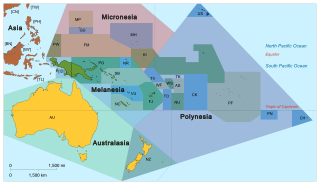
Pacific Islanders, Pasifika, Pasefika, or rarely Pacificers are the peoples of the Pacific Islands. As an ethnic/racial term, it is used to describe the original peoples—inhabitants and diasporas—of any of the three major subregions of Oceania.

Gehyra is a genus of geckos in the family Gekkonidae. They are known as web-toed geckos or dtellas, and most species within the genus bear close resemblance to geckos from the genus Hemidactylus.
Polynesians form an ethnolinguistic group of closely related people who are native to Polynesia, an expansive region of Oceania in the Pacific Ocean. They trace their early prehistoric origins to Island Southeast Asia and form part of the larger Austronesian ethnolinguistic group with an Urheimat in Taiwan. They speak the Polynesian languages, a branch of the Oceanic subfamily of the Austronesian language family.

The Lapita culture is the name given to a Neolithic Austronesian people and their material culture, who settled Island Melanesia via a seaborne migration at around 1600 to 500 BCE. They are believed to have originated from the northern Philippines, either directly, via the Mariana Islands, or both. They were notable for their distinctive geometric designs on dentate-stamped pottery, which closely resemble the pottery recovered from the Nagsabaran archaeological site in northern Luzon. The Lapita intermarried with the Papuan populations to various degrees, and are the direct ancestors of the Austronesian peoples of Polynesia, eastern Micronesia, and Island Melanesia.

Gehyra mutilata, also known commonly as the common four-clawed gecko, Pacific gecko, stump-toed gecko, sugar gecko in Indonesia, tender-skinned house gecko, and butiki in Filipino, is a species of lizard in the family Gekkonidae. The species is native to Southeast Asia. It has made its way to several areas of the world including Sri Lanka, Indochina, and many of the Pacific Islands. Compared to the common house gecko, the appearance of G. mutilata is somewhat plump, with delicate skin. The skin is usually colored a soft purplish/pinkish gray, with golden spots on younger specimens; these spots eventually fade with age.

Near Oceania is the part of Oceania settled 35,000 years ago, comprising Australia, New Guinea, and north-western Island Melanesia: the Bismarck Archipelago and the Solomon Islands.

Melanesians are the predominant and indigenous inhabitants of Melanesia, in a wide area from the Maluku Islands, East Nusa Tenggara and New Guinea to as far east as the islands of Vanuatu and Fiji. Most speak either one of the many languages of the Austronesian language family, especially ones in the Oceanic branch, or from one of the many unrelated families of Papuan languages. Other languages are the several creoles of the region, such as Tok Pisin, Hiri Motu, Solomon Islands Pijin, Bislama, Ambonese Malay and Papuan Malay.

Oceanic art or Oceanian art comprises the creative works made by the native people of the Pacific Islands and Australia, including areas as far apart as Hawaii and Easter Island. Specifically it comprises the works of the two groups of people who settled the area, though during two different periods. They would in time however, come to interact and together reach even more remote islands. The area is often broken down into four separate regions: Micronesia, Melanesia, Polynesia and Australia. Australia, along with interior Melanesia (Papua), are populated by descendants of the first waves of human migrations into the region by Australo-Melanesians. Micronesia, Island Melanesia, and Polynesia, on the other hand, are descendants of later Austronesian voyagers who intermixed with native Australo-Melanesians; mostly via the Neolithic Lapita culture. All of the regions in later times would be greatly affected by western influence and colonization. In more recent times, the people of Oceania have found a greater appreciation of their region's artistic heritage.
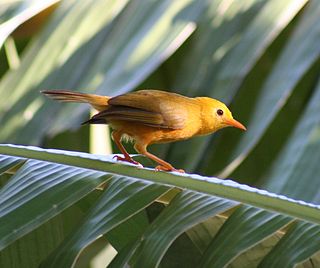
The golden white-eye is a species of bird in the white-eye family, Zosteropidae. It is the only species within the genus Cleptornis. The golden white-eye was once considered to be a honeyeater in the family Meliphagidae and although it is now known to be a white-eye, its position within that family is still uncertain. The species is restricted to the islands of Saipan and Aguijan in the Northern Mariana Islands, where it is sympatric and competes with the related bridled white-eye. The golden white-eye has golden plumage and a pale eye-ring. It feeds on insects, fruit, and nectar and forages in pairs or small family groups. The bird is monogamous and lays two eggs in a small cup nest.
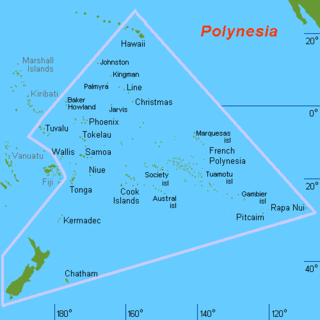
Polynesia is a subregion of Oceania, made up of more than 1,000 islands scattered over the central and southern Pacific Ocean. The indigenous people who inhabit the islands of Polynesia are called Polynesians. They have many things in common, including language relatedness, cultural practices, and traditional beliefs. In centuries past, they had a strong shared tradition of sailing and using stars to navigate at night. The largest country in Polynesia is New Zealand.

Lepidodactylus lugubris, known as the mourning gecko or common smooth-scaled gecko, is a species of lizard, a gecko of the family Gekkonidae.

The dubious dtella, native Australian house gecko, ordubious four-clawed gecko is a species of gecko in the genus Gehyra, native to Northeastern Australia. The lizard is found in a variety of habitats, including acacia and eucalyptus woodlands, and in human-developed habitats, such as house walls in urban areas. Its urban presence makes it known as a common house gecko in Queensland. These geckos are often confused with the Asian common house gecko, which was introduced to Australia from Indonesia, but G. dubia has distinct rounded feet and quieter calls.
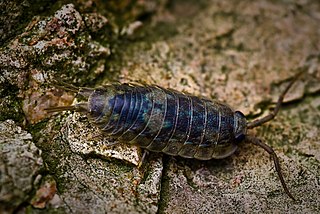
Ligia is a genus of isopods, commonly known as rock lice or sea slaters. Most Ligia species live in tidal zone cliffs and rocky beaches, but there are several fully terrestrial species occur in high-humidity environments.
Nuguria (Nukuria) was a Polynesian language, spoken by approximately 550 people on Nuguria in the eastern islands of Papua New Guinea. The language was taught in primary schools in Nuguria and was used for daily communications between adults and children. Nuguria is one of the eighteen small islands to the east of Papua New Guinea, which are known as the Polynesian Outliers. The Nukuria language has been concluded to be closely related to other nearby languages such as Nukumanu, Takuu, Nukuoro, and Luangiua. Research on the Nuguria Atoll and the language itself is scarce; past research demonstrated that this language was at risk of potential endangerment. The language was only then classified as at risk of endangerment because it was still used between generations and was passed on to the children. However, recent research indicates that Nukuria is now most likely an extinct language.
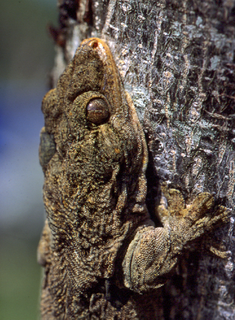
Gehyra georgpotthasti is a species of web-toed gecko, found on several Melanesian and Polynesian islands.

One of the major human migration events was the maritime settlement of the islands of the Indo-Pacific by the Austronesian peoples, believed to have started from at least 5,500 to 4,000 BP. These migrations were accompanied by a set of domesticated, semi-domesticated, and commensal plants and animals transported via outrigger ships and catamarans that enabled early Austronesians to thrive in the islands of Maritime Southeast Asia, Near Oceania (Melanesia), Remote Oceania, Madagascar, and the Comoros Islands.
Harvey Alfred Miller was an American botanist, specializing in Pacific Islands bryophytes.















